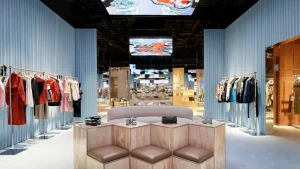Burberry stole the spotlight at the 2024 London Fashion Week with its showstopping finale. Along with the National Theatre extravaganza, it attracted high-profile guests, including Olympians, footballers, and ’90s rock stars.
The label was founded in 1856 by Thomas Burberry, who wanted to create a clothing range to protect people against the British weather. It now operates around 500 stores globally, with a significant presence in China.
Renowned for their signature trench coat, scarves, and hats, the British heritage brand is now pushing the boundaries of fashion and technology, claims its director of digital delivery, Jon-Paul Brett.
Brett talked at length about the brand’s digital endeavours at this year’s Connected Britain, held at London’s Excel earlier this month.
With an IT and project management background, Brett has worked at Burberry in various roles for the last nine years, now heading up the retailer’s global digital delivery division.
At the connectivity conference, Brett said the retailer is focused on creating omnichannel journeys for customers that combine physical and digital experiences.
Brett added that the retailer was also looking to partner with big and small tech firms to work on bespoke products for its high-end customer base.
We outline five key ways the Burberry boss believes technology is transforming high-end retail.

Jon-Paul Brett, Director of Digital Delivery, Burberry
1. Using predictive AI to check inventory and increase personalisation
According to Brett, Burberry has a close relationship with its customers. Still, there’s always more that can be done to personalise and improve this service, like with predictive AI and recommendation engines.
With the help of machine learning, the brand claims it can now predict its customers’ preferences by leveraging all accessible data to improve online and in-store experiences by offering tailored recommendations and using customers’ social media accounts to communicate with them.
“Our store associates and customers are often on first-name terms and have a relationship built over time,” Brett explained.
“A customer may have pre-booked a personal appointment with an associate who can send them a virtual clothes rail through an online form consisting of the latest Burberry items.
“They can select what they want off the rack and then visit the physical store. That physical rail can be in their dressing room waiting for them,” Brett added.
Customers who interact with the brand via Facebook may even arrive at the store via an Uber. The store’s Facebook chatbot can alert customers about new products and book them a ride to their nearest store.
The physical experience also then loops back to the digital. Some in-store products are fitted with radio frequency identification (RFID) tags that send information to customers’ mobiles, delivering information like product recommendations and styling suggestions.
AI is also having a huge impact on the luxury market regarding managing its global inventory. Brett adds: “With luxury retail, it’s quality over quantity, so it’s about getting that inventory right in terms of sizes and working out what product is in what store at what time.
“There are so many variables that can affect stock too: particularly the weather, social media, celebrity product placement — you can have a huge surge in one area, making supplies hard to predict. So using predictive AI as an inventory tool is critical,” he said.
2. Using blockchain to convey brand lineage and sustainability
Ethical and sustainable practices are becoming more important in fashion, especially among consumers.
According to Brett, weaving a narrative around Burberry’s products, where transparency, authenticity, and sustainability are crucial parts of the story, is something he thinks technologies like blockchain can help deliver.
Blockchain is a distributed and decentralised ledger technology that securely records and verifies transactions over a network of computers.
The technology can be used in fashion to establish an unalterable and transparent record of a product’s journey from its inception to the consumer’s hands.
In a proof of concept, Burberry collaborated with IBM to create a blockchain solution to streamline its supply chain operations, from sourcing raw materials to distributing finished products.
“So, you could scan a QR code on one of our trench coats and look at the story that has brought that coat into being — from the farm and the field where cotton has come from, right through to where that cotton was spun, and which one of our sites has manufactured it,” Brett adds.
“You have this story about an individual item that really shows the lineage of our luxury brand and the technology backbone that sits underneath that,” he explained.
Fashion and metaverse market to reach over $6 billion by 2026
3. Creating a “phygital” experience to drive people into stores
According to Brett, what drives people into stores now, particularly in luxury retail, is a combination of physical and digital experiences that Brett calls “phygital”.
Over the last decade, fashion retailers have invested heavily in social media to target upmarket millennials and revamp their image.
However, with platforms like Facebook and Instagram banned in China, one of its biggest territories, retailers need to rethink their approach in this market.
Burberry decided to partner with China’s tech giant Tencent to create a ‘Social Retail Store’ in Shenzhen, which merges online interactions with physical retail experiences.
The 539-square-meter store comprises ten spaces celebrating Burberry’s heritage while offering interactive encounters.
The store’s entrance features a window which responds to body movements, creating immersive moments that can be shared on social media.
Inside the store, three immersive fitting rooms offer personalised experiences, with QR codes linking products to digital screens for additional content and storytelling.
Tencent also developed a custom-made, in-store WeChat application (China’s answer to WhatsApp) that provides exclusive content, audio guides, appointments, and events.
Through gamification, customers also received playful digital animal characters evolving with interactions and QR codes that facilitated access to new collections and store exclusives.
“So, there you have lots of gamification, AI-driven experiences where you can put on a headset or see existing products through a mobile phone. In a post-Covid world, retail has become much more of a hybrid experience,” Brett said.
He added that hologram-enabled catwalks that pull people into its stores are another area he sees “growing this year and evolving in several different ways.”

A still of Burberry’s digital store
4. Using tech to create an engaged, hybrid workforce
Burberry operates a hybrid work policy, although Brett acknowledged that it’s better sometimes to be in the office for collaborative exercises.
That said, he noted that workflows were constantly evolving and becoming more collaborative places.
“From a technology perspective, we’ve seen a shift from knowledge-based workers working in silos, on documents like Excel, who then moved to work on online versions of the same product.
“And now they are moving to a SaaS model where we’re sharing and collaborating at the same time — with AI-driven over the top, as well as real-time data on sales, on connectivity and on performance.”
Looking to the future, Brett said the store is looking at internal ways that staff might benefit from future platforms like the metaverse.
“We’re looking at that side of things for many different elements: from training to Town Halls to meetings, from an engagement perspective. For instance, it could make things like mandatory safety training in our factories more engaging. Hybrid working is here to stay!”
5. Co-creating products and experiences through tech partnerships
In technology terms, Brett noted that the drive for newness in retail had become relentless and that partnerships with tech companies are becoming an area they want to expand.
“Whereas a decade before, we’d put in a [connected] magic mirror in one of our stores, and it would be there for several years and still be seen as very advanced. Now, the pace of change is so fast that we need to adopt and bring out new technology to engage with customers more frequently.
“So, we need industry to partner with us, to quickly experiment and adapt with the understanding that it might only run for a year or two. And then we’ll need to reinvent again,” he said.
What Burberry is looking for from a partner perspective, Brett added, is the ability to co-create and be sympathetic to its needs as a luxury retailer.
“Lots of providers invent in a box and then try and find a use for it — but we are very different from FMCG retail — this is not a one-tech-fits-all situation.
“That’s where we often struggle to get the right partners because they are always looking to sell upfront rather than wanting to work on a joint product at the end.”
Brett told TechInformed that Burberry was particularly interested in forming partnerships with AI vendors.
“Because the area is so new, very few companies are proven in a way that reacts well to our industry. Very few companies have done that well in the luxury sector.”
In terms of partnerships that have been successful for the retailer, he added that there have been two kinds so far.
“There are those small-scale innovative firms that are often in their third, fourth, fifth years and then the usual much larger big tech providers.
“But we are getting a much clearer understanding of where to go and whether something needs to scale globally or test in a local market first.”